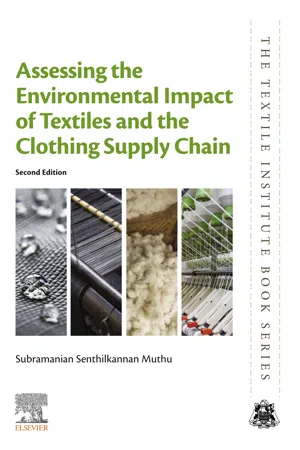
Assessing the Environmental Impact of Textiles and the Clothing Supply Chain
- 204 pages
- English
- ePUB (mobile friendly)
- Available on iOS & Android
Assessing the Environmental Impact of Textiles and the Clothing Supply Chain
About this book
Assessing the Environmental Impact of Textiles and the Clothing Supply Chain, Second Edition, is a fully updated, practical guide on how to identify and respond to environmental challenges across the supply chain. This new edition features updates to important data on environmental impacts and their measurements, the sustainable use of water and electricity, and new legislation, standards and schemes. Chapters provide an introduction to the textile supply chain and an overview of the methods used to measure environmental impacts, including greenhouse gas emissions, water and energy footprints, and a lifecycle assessment (LCA) on environmental impacts.This book will be a standard reference for R&D managers in the textile industry and academic researchers in textile science.- Provides a holistic view of the sustainability issues that affect the textile value chain- Explains ways to calculate the textile industry's use of resources, its impact on global warming, and the pollution and waste it generates- Reviews key methods for the reduction of the environmental impact of textile products and how they are implemented in practice- Includes methods for calculating product carbon footprints (PCFs), ecological footprints (EFs) and lifecycle assessments (LCA)
Frequently asked questions
- Essential is ideal for learners and professionals who enjoy exploring a wide range of subjects. Access the Essential Library with 800,000+ trusted titles and best-sellers across business, personal growth, and the humanities. Includes unlimited reading time and Standard Read Aloud voice.
- Complete: Perfect for advanced learners and researchers needing full, unrestricted access. Unlock 1.4M+ books across hundreds of subjects, including academic and specialized titles. The Complete Plan also includes advanced features like Premium Read Aloud and Research Assistant.
Please note we cannot support devices running on iOS 13 and Android 7 or earlier. Learn more about using the app.
Information
Introduction to sustainability and the textile supply chain and its environmental impact
Abstract
Keywords
1.1. Introduction
1.2. Environmental sustainability
- ❖ raw materials,
- ❖ energy consumption,
- ❖ water consumption,
- ❖ waste water discharge or water pollution,
- ❖ soil or land pollution,
- ❖ emissions to air,
- ❖ greenhouse gas (GHG) emissions or carbon footprint,
- ❖ hazardous waste management,
- ❖ toxic and hazardous chemicals management, etc.
1.3. Social sustainability
Table of contents
- Cover image
- Title page
- Table of Contents
- The Textile Institute Book Series
- Copyright
- 1. Introduction to sustainability and the textile supply chain and its environmental impact
- 2. Ways of measuring the environmental impact of textile processing: An overview
- 3. Textile processing and greenhouse gas emissions: Methods for calculating the product carbon footprint of textile products
- 4. Calculating the water and energy footprints of textile products
- 5. Textile processing and resource depletion: Calculating the ecological footprint of textile products
- 6. Estimating the overall environmental impact of textile processing: Life cycle assessment of textile products
- 7. Life cycle assessment and product carbon footprint modelling of textile products
- 8. End-of-life management of textile products
- 9. Measuring the environmental impact of textiles in practice: Calculating the product carbon footprint and life cycle assessment of particular textile products
- 10. Assessing the environmental impact of textiles: Summary and conclusions
- Index